Modular Synth Masterclass: Modules and Modulation
In the third part of our in-depth look at building Eurorack Modular Synths Dave Gale focuses on sequencing and modulation, with Eurorack modules that can tweak, mutate and distort those beautiful tones… Read Part 1 Here Read Part 2 Here One of the attractions of the modular system, to the synthesist, is the ability to […]
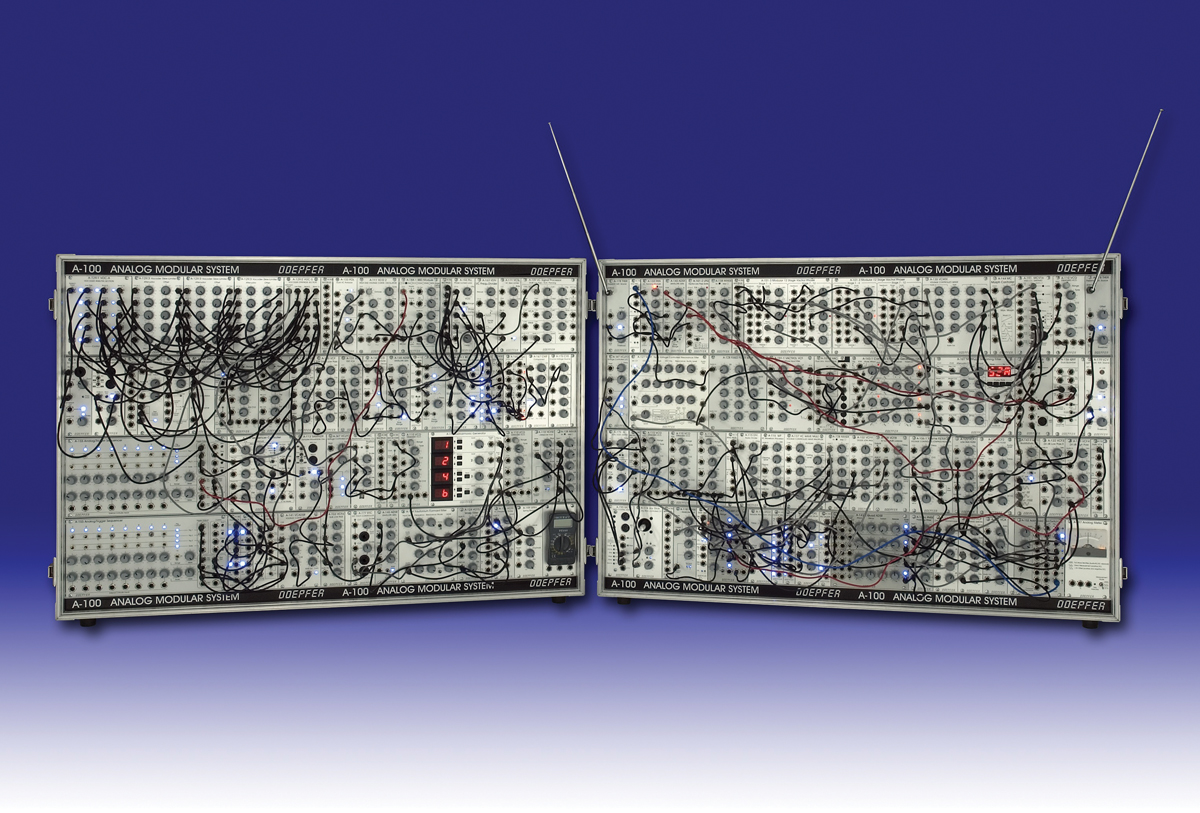
In the third part of our in-depth look at building Eurorack Modular Synths Dave Gale focuses on sequencing and modulation, with Eurorack modules that can tweak, mutate and distort those beautiful tones…
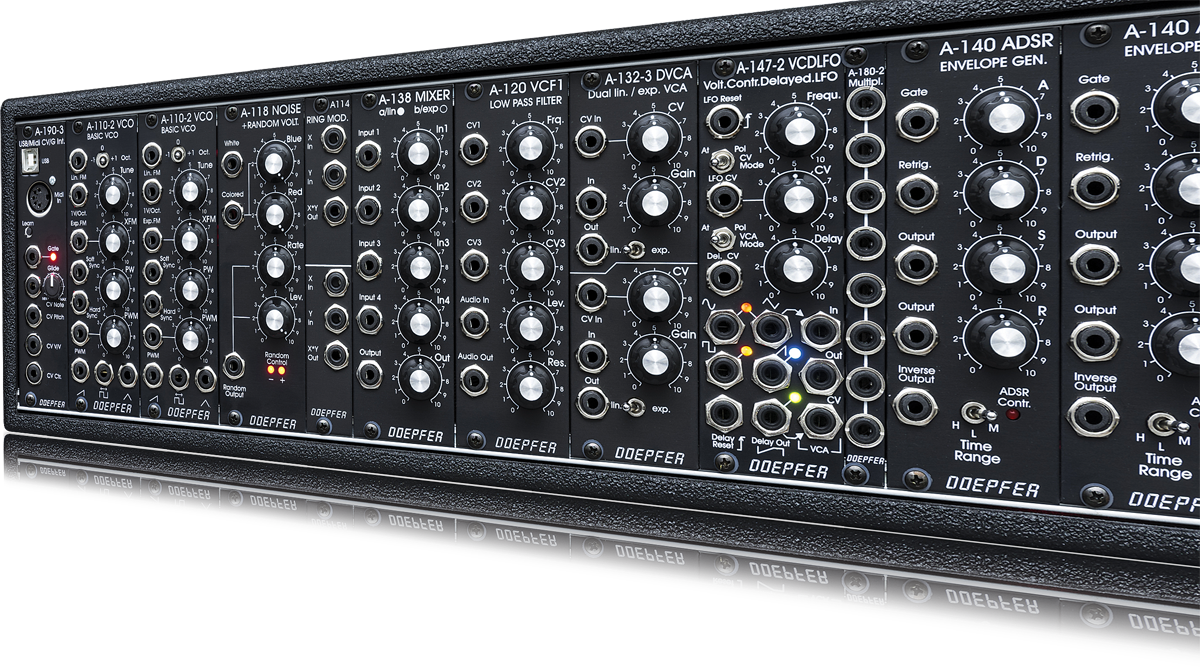
One of the attractions of the modular system, to the synthesist, is the ability to be able to take an audio or CV signal and apply any number of modulations
and mutations to it.
Part of this is the inevitable experimentation, after all, many great sounds can start from a happy accident (think Gary Numan stumbling across a Minimoog for the first time). But with time and experience, you learn that if you apply X to Y, you will get… well, something weird, esoteric and quite possibly wonderful, all linked together in some form of sequence. This is the main thrust of our theme this month.
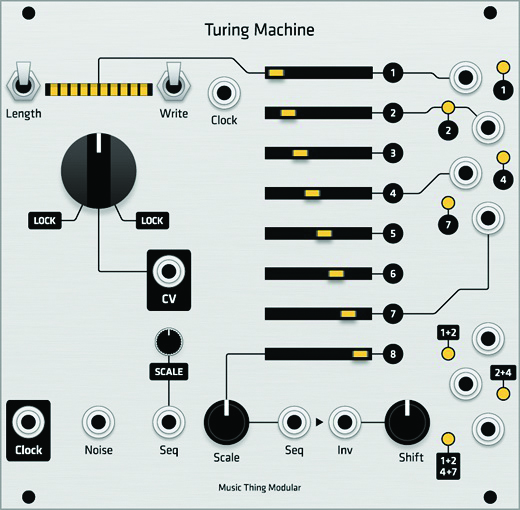
Like, so random: The Turing Machine is the ultimate randomising unit, complete with trigger outputs for even more possibilities
Modulation, That’s What You Need
Most of us know and understand that 99 per cent of all commercially available synths have two controls (normally to the left of the keyboard) – these being the pitch wheel/lever and a modulation wheel/control.
We generally understand that tweaking the pitch wheel or lever will flatten or sharpen the note pitch, often by extreme amounts of up to an octave, but also that the second wheel/control has traditionally always been for applying pitch modulation to a note, usually via a low-frequency oscillator or LFO, as you will often see by the legend.
This is normally the default setting, yet it’s often possible to apply other modulations to the mod wheel. In a Eurorack modular, the wheel isn’t normally present. However, enticingly enough, you can connect LFOs to all manner of locations to create a modulating effect.
The most common and cheapest forms of LFO are free-flowing: which is to say that they generate a low oscillation at a frequency which is not connected to anything else. There is a plentiful supply of these to choose from, starting with the most ubiquitous of modular manufacturers, Doepfer. The A-145 offers you a healthy choice of five LFO waveforms, along with a frequency control, which allows for determination of speed of oscillation. Alongside this is a handy three way selector switch, which will take you from an incredibly slow oscillation right the way up to something in the audio range. There’s also a useful Reset input, which will begin the oscillation every time it receives a gate trigger; this can be helpful, but should not be confused with a Clock Sync input (more on this later).
Talking of LFOs that extend into the audio range, some VCOs and DCOs will not only operate as regular oscillators, but also have the option to be used in LFO mode. This is a throwback to the days of the Minimoog, where there was no dedicated LFO, forcing the user to select LFO mode on one of the VCOs in order to achieve a modulating vibrato or similar.
A good example of a Eurorack module that exploits this option is the MiniMod VCO, made by British company AJH (it’s hardly surprising, given that this VCO is a Minimoog Model D replica, that it should have this functionality). Pittsburgh Modular, Studio Electronics and others offer other dedicated and free-flowing LFOs.
In tune with some standalone synths, an LFO can also be deployed to a secondary oscillator, which is sync’d to a primary oscillator. The change in frequency of the secondary oscillator only, while swept against the primary oscillator, creates the classic Sync tone often exploited by the likes of Daft Punk. Depending on your oscillators, you may be able to sweep through the waveforms with your LFO, which creates superb tones, especially if set to a very slow oscillation.
This works exceptionally well with certain digital oscillators, especially those which are Wavetable based. One very familiar effect currently being used in many commercial tracks is the pumping effect, which would traditionally be handled with sidechain compression, and now by using pumping plug-ins via a DAW. However, the same effect can be obtained with an LFO, set to a ramp, heading in the direction of the VCA. For a more complicated take on this, try sending the same signal to the filter cutoff – you’ll get the pump, with a shade of filter shaping thrown in.
The resulting pumping effect will sound terrific, but what happens when you want to use it in your track? This is the point where you discover you can’t clock your LFO, which you will almost certainly want to do in this situation. A ‘Clockable LFO’, then, as the name suggests, is an LFO that will accept an incoming clock signal from another device within the Eurorack.
This will, in turn, result in the LFO oscillating in tempo with the rest of your system, sequence or track, and takes the reset quotient seen elsewhere to the next level. The added bonus here is definitely to musical ends, as a whole world of rhythmically accurate, LFO-based pulses and oscillations can be deployed. Although generally higher in price, the payoff may be worthwhile. A unit worth investigating here is the Vermona fourMulator, which offers no fewer than four independent LFOs, all sync’able from an external source, and each other. There’s an argument that this high-value unit may even remove the need for any other LFO in your system.
However, there is another way of looking at the clockable LFO conundrum, and this has more to do with an attack and release-based envelope. One such device is the aptly named Envelope from Pittsburgh Modular, which enables the user to set both attack and release phases to behave much like a sine, triangle or saw/ramp-based LFO, but can also double as a regular envelope – and so we start to enter the world of multi-function devices, which can be more cost effective in a Eurorack system. Another unit which takes the idea of LFO-by-stealth to yet another level, is the Make Noise Maths.
This exceptionally popular unit is favoured by many as the CV modulator of choice, as it is able to simulate LFO effects, but also has the ability to add and subtract CVs internally – hence the name. As any Make Noise owner knows, the Maths is not for the faint hearted, as the layout and I/O description can appear vague and somewhat complicated at first sight. But investing in learning how this unit works will yield some extraordinary results, which would be difficult to replicate elsewhere.
As a friend of mine put it, “The Maths is a CV modulator for people who like Marmite.” However, don’t view this as a negative; you’ll merely have to spend some time pouring over the manual and scratching your head before you get what you want from it, which is no bad thing with any new module.
Mutable Instruments has a reputation for offering plenty of functionality in its modules, and the closest module it offers to an LFO is Tides, which is billed as a ‘tidal modulator’.
In essence, this will work as a clockable LFO, but offers frequency cycles down to one cycle per minute – which is the lowest frequency I think I’ve ever come across on a functional unit. Outside of this quirk, it also offers more conventional functionality, including a mode as a regular oscillator, in audio range.
I’ve always been a fan of radomising modulation sources, and one such option, which is often linked with LFOs is the Sample and Hold or Random CV generator. While many synths often include this component in their LFOs, in the Euro world they tend to be on separate units, and often with good reason, due to the vast number of flexible options available.
Basic random units, which do exactly what they say they should, are available from the usual suspects, but one of my favourite random generators is the Turing Machine from Music Thing Modular, which is available as a build with various add-ons.
In its most basic form, the Turing will generate and send out random CVs, which can then be locked into a looped pattern, with the added bonus of a clock input, so that the CVs fall in time with your given sequence. This can sound glorious when applied to the usual sources, such as filter cutoff, but with some of the optional expansion elements added, will allow for control of the sequence and even triggering, all of which make up a highly usable randomising module.
This has all the benefits of a Sample and Hold module, but with so many further possibilities. If the idea of building the kit is something you don’t feel comfortable with, you could either go back to college to learn some basic electronics, or (more likely) have a look on eBay for ready-built units… but expect to pay more for a completed unit than the sum of the original parts.
Attenuation
Sometimes, a little more control might be desired when routing a CV from one location to another, as any form of control for this purpose might be lacking on the original source module. It’s a problem which is more common than you think, and one solution is to invest in a set of attenuators.

The Doepfer A-183-1 offers a very simple solution. Route your ‘hot’ CV through one of two channels, and attenuate the signal, to offer more control. Mutable Instruments Shades offers much the same thing, but with a couple of additions; it’s also an audio mixer, which can make for a more flexible purchase.
Where To Send Your CV
As will hopefully be becoming clear, there are all manner of locations where CV signals can be sent in a Eurorack, and certainly, it’s a great idea to experiment. Apart from the usual suspects, such as PWM on a square wave and cutoff on a filter, have a look at what else may be available.
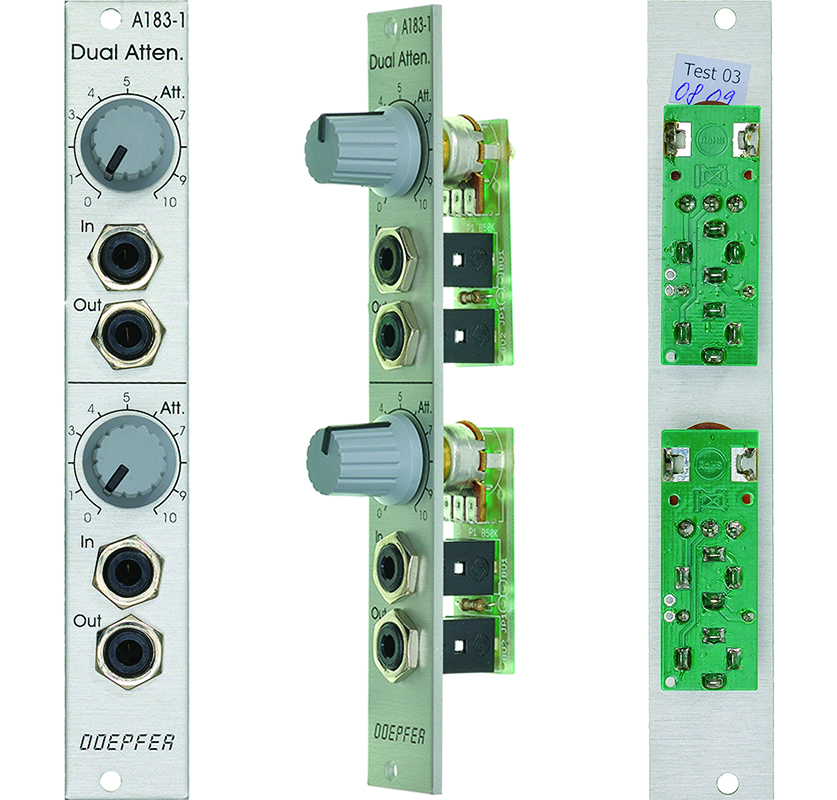
Most modules will offer some degree of CV control: so as a starting point, take a CV output from an LFO and try whatever options may be available. Some less obvious locations to try, if available, are the various phases of an ADSR envelope – an ever-changing release phase, for example, will give a superbly interesting rhythmic effect, and help to make your sound feel more humanistic
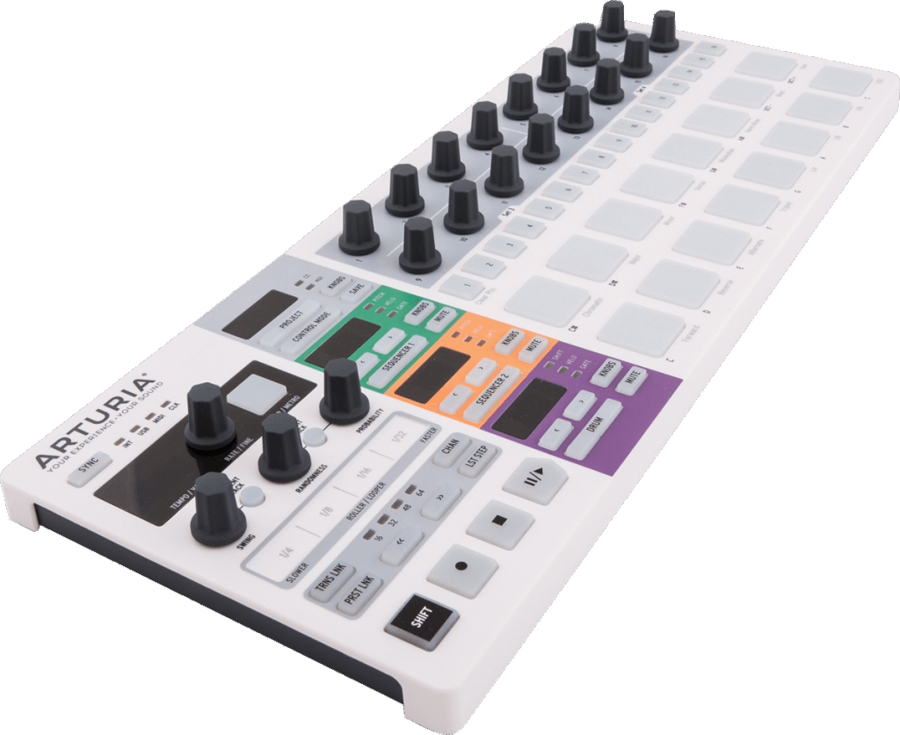
Beatstep Pro enables you to control two channels of CV and Gate
Sequencing Options
Random elements within your Eurorack are all very well, but you may well be of a mindset that requires a little more control over your sonic creations. With this might come the need for some ability to both control and structure your CVs, so the chances are, you’re going to need a sequencer. Arturia made the brave step, some years ago, of embracing the old format of CV and Gate with some of its new products. This was much to the delight of the Eurorack community, as products began to appear with MIDI and CV/Gate functionality.
Nowhere is this more in evidence than with Arturia’s latest flagship sequencer offering, the Beatstep Pro. Although not a Eurorack module, this desktop unit will allow you to control two channels of CV and Gate, along with a host of drum triggers, with the added advantage of being able to work on pattern lengths of up to 64 steps.
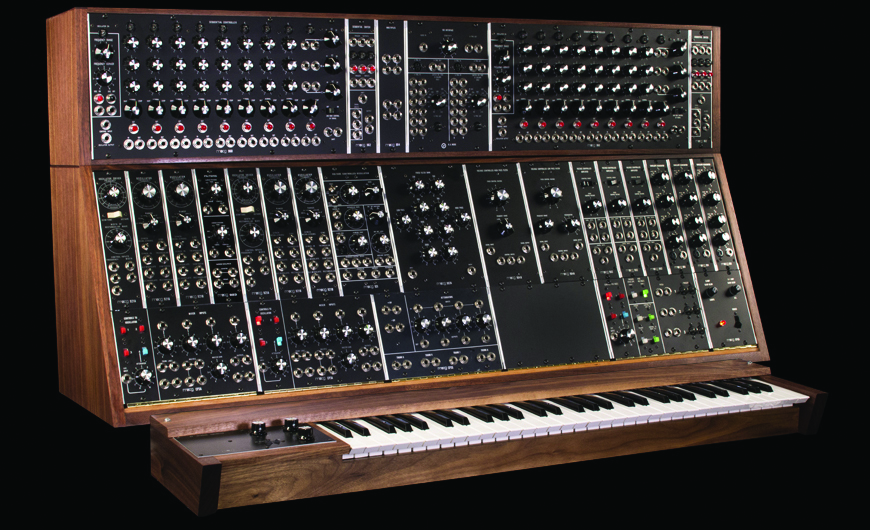
Moog’s recreation of its classic Modular System
As if this weren’t enough, the Beatstep Pro will also allow the user to place the patterns in a song format, or ‘Project’, in much the same way good old-fashioned drum machines and sequencers would –and here, we’re thinking 808s, 909s and 303s! In fact, the Beatstep will also sync with 303s, thanks to
the Sync 24 output, and will operate as a master clock or allow a sync from a clock on your modular.
To say that the Beatstep Pro is comprehensive is an understatement. It really does cater for just about every eventuality, although, strangely, it’s not for everyone, as some still prefer the idea of working with a more basic sequencer and driving it manually. In this camp, the Korg SQ-1 is about as basic as it gets, offering a small unit which happily sits on the desktop; although, again, it’s not in a Eurorack form (Korg – it would be lovely in a Eurorack module… please?!). I love my little SQ-1 – it’s perfect for just firing up and noodling with a sequence on the fly, and in this respect, it feels as though it has more in common with its analogue roots.
In a similar vein, the Tiptop Audio Z8000 matrix sequencer offers a number of different sequencing options. In fact, it offers up to 10 simultaneous sequences; 8 x 4-step and 2 x 16-step. Certainly, you’ll need to pay attention while using all 10, as it will be very easy to tweak the wrong CV. But with practice, this can work really well in a system.
For many, though, the current sequencer of choice is the Intellijel Metropolis, which offers more than a passing nod to the Roland systems of 40 years ago.It’s very comprehensive and offers lots of tricks, such as the favourable glide from the Roland TB-303, and does so within a sizeable 34HP form.
It’s worth remembering that as well as the traditional concept of sequencing CV and Gate signals, which in many respects will be the starting point for most, CVs can be sent in so many directions, as pointed out earlier. Don’t be afraid to patch a CV output to the input on a device which has a tempting mini-jack socket. If you’re not sure what it does, you might open up a whole palette of sonic possibilities.
Getting An External Signal into Your Modular
It can be really helpful to be able to feed a signal from elsewhere into your modular, especially if you find yourself noodling with sounds from the real world, but you’ll find most audio signals will need a little extra help to get into your Eurorack.
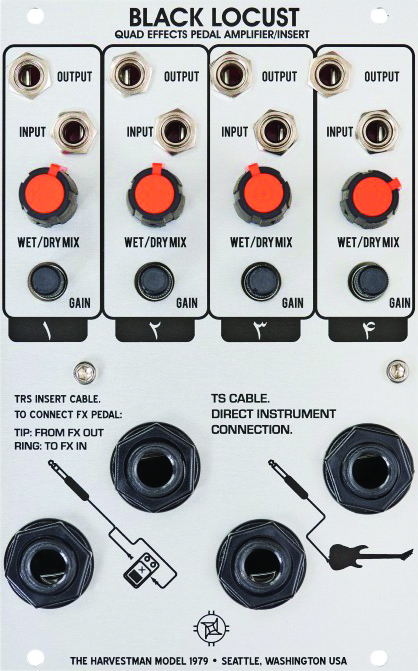
One option to investigate is the Doepfer A-119 External Input, which will happily accept a guitar or microphone signal, and boost them to something useable. The Pittsburgh Modular InOut, and the Harvestman Black Locust both offer much the same functionality.
Need More Cowbell?
In the midst of all of this wonderful noise making, there may be something missing, and that might just be a groove! In which case, the addition of some form of drum pattern might be on the agenda. This being the case, there are a couple of directions to go, and plenty of choice.
One of the best and cheapest boxes on the market is Volca Beats from Korg. This superb little (mostly) analogue drum machine sounds awesome, and at just under £100, it won’t break the bank.
If you fancy a shade more control and flexibility, Tiptop Audio and Hexinverter both have excellent reputations for Eurorack drum modules, whether you’re looking for 808/909-type sounds, or something a little different – but with flexibility comes a higher price.
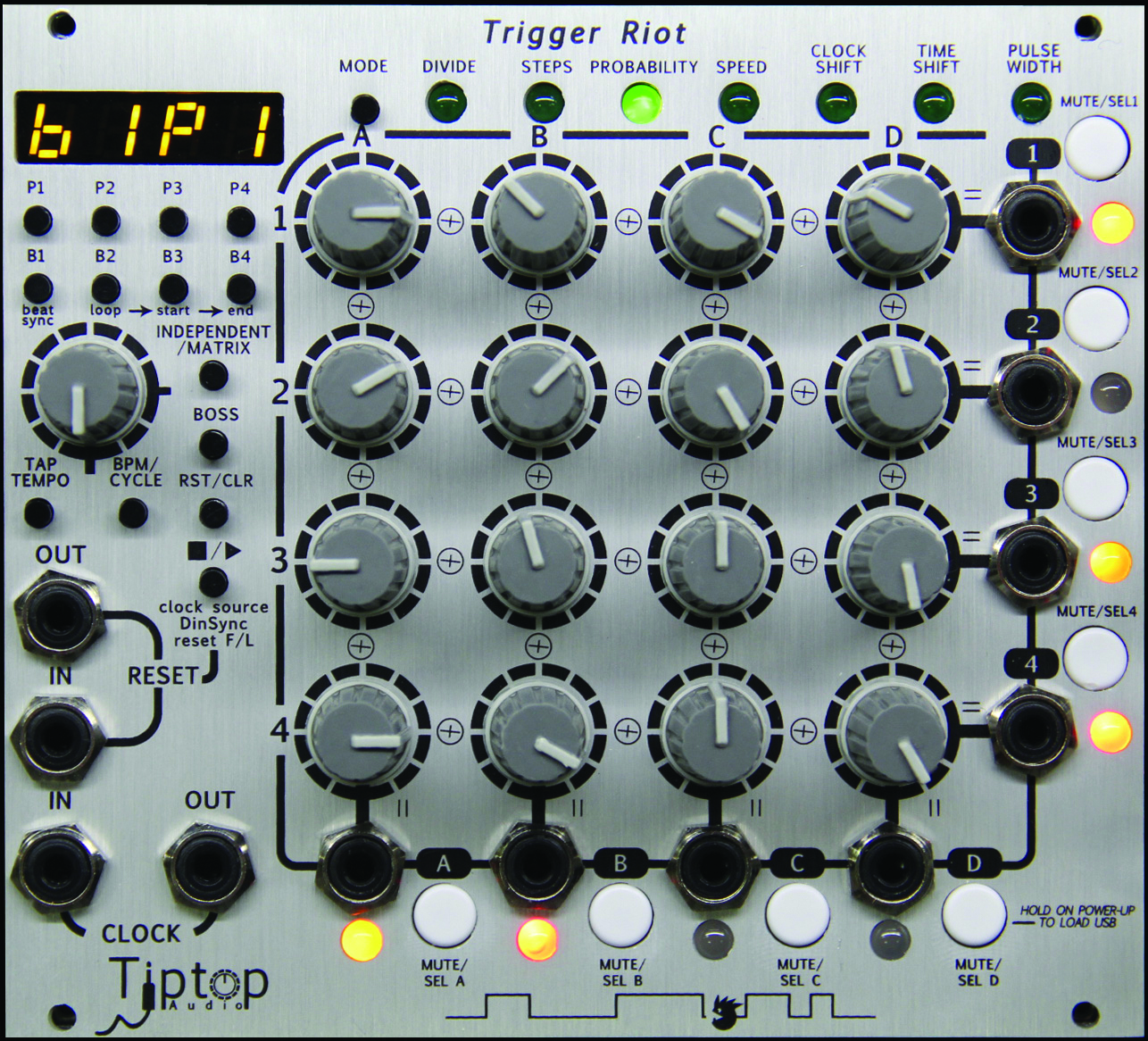
Don’t forget, though, that armed with a filter and some white noise, plenty of drum-like noises can be achieved from a modular. You will also need something to trigger your drum sounds, of course, and the Beatstep Pro will happily help with this. Or if you’re looking for something more Eurorack-specific, you should audition the Tiptop Audio Trigger Riot, or the Doepfer A-157 Trigger Matrix.
Audio Modulation
So far, pretty much everything I’ve discussed has been of the CV or Gate signal flavour, but there’s an emerging market in Eurorack devices which will process audio signals.
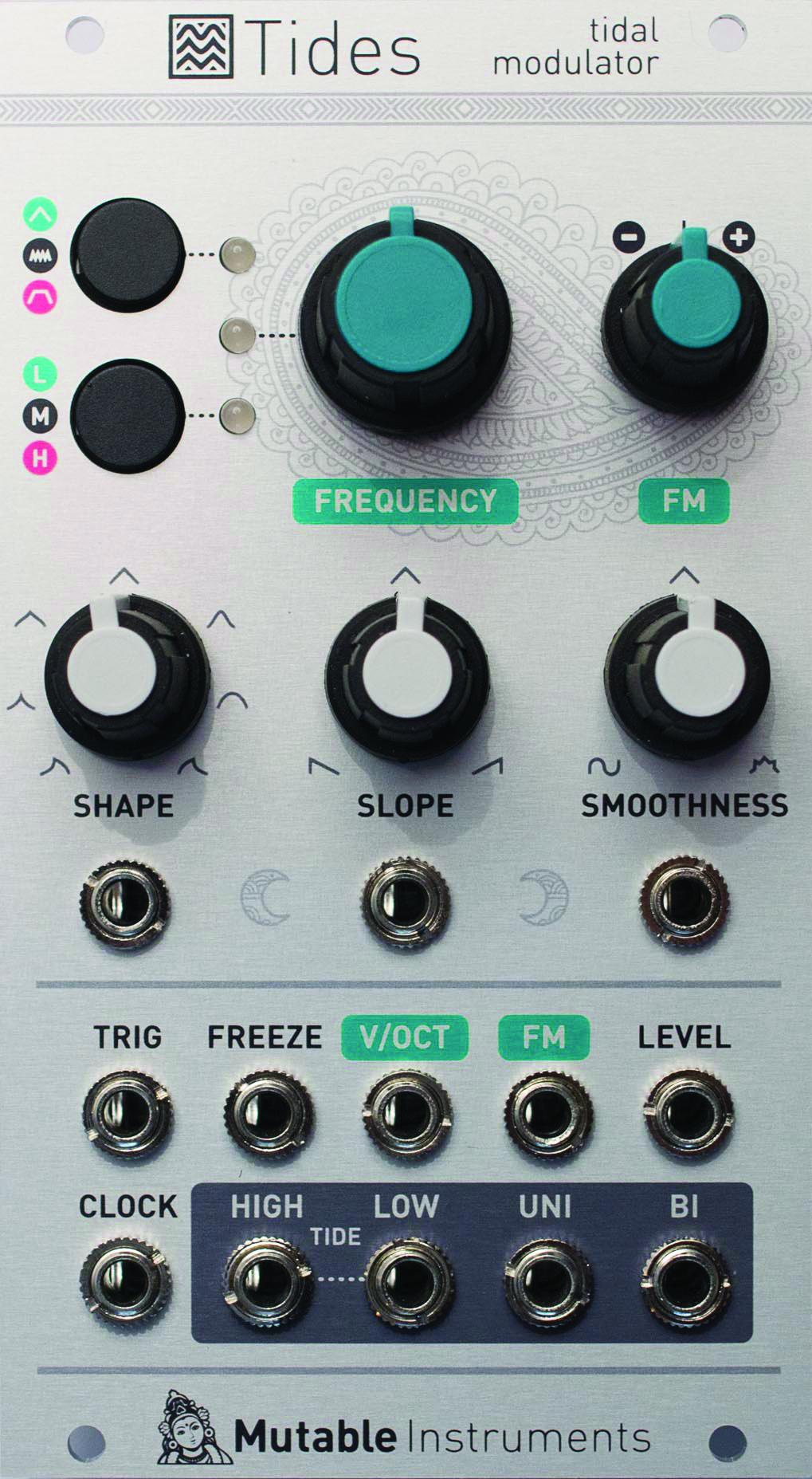
It’s Tidal, and not just your usual LFO. Packed with plenty of functionality
Harking back to traditional signal processing, reverbs and delays will always be popular. There are essentially two flavours of Eurorack reverb – digital and analogue (spring). Favoured digital designs come from the likes of Make Noise, whose Erbe-Verb offers a very high-end, but crisp, reverb with plenty of CV control.
Do remember that if you just want a splash of reverb, rather than lots of CV-based real-time control, there is a whole world of cheaper pedals and 19-inch units out there. The latter have largely fallen out of favour of late, thanks to the huge wealth of DAW-based plug-ins that are widely available. As with all things modular, it just depends on what you want to do, and how you want to get there.
Having said that, Eurorack spring reverbs tend to be a lot cheaper, and again, Doepfer offers a nice cost-effective solution in the A-199 Spring Reverb module. Just about all spring reverbs will consist of a two component setup; the Eurorack module and a spring tank, which is normally fixed or screwed to the inside of your chosen cabinet or case. For well under £100, you can get the authentic spring-reverb sound that was the starting point for all reverbs when those now-vintage synths first appeared on the market.

Fancy yourself a cable guy? The Eurorack approach will make you think about sound design differently
And in this respect, it will sound very authentic and classic in timbre. Another spring reverb which is absolutely worth a look, is the superbly named Intellijel Springray. The module can be paired with up to three different spring tanks, all of which can be purchased directly from Intellijel. You get complete flexibility from one unit, under CV control, and that classic spring sound.
Next on the Eurorack effects radar would have to be some form of delay. And there’s quite a choice! All manner of bucket-brigade delays (BBDs) are available from many of the names we’ve already mentioned – Doepfer, Pittsburgh, Make Noise, all make their own flavour (in case you’re wondering, bucket-brigade delays are named to conjure the notion of a line of people transferring water from one bucket to another, as the delay does with the audio signal).
However, there are a couple of new kids on the block which are worth a look. Roland has had many of us chomping at the bit for the last year, with its much-anticipated sojourn back into the world of synthesis, with the appearance of so many Eurorack-based products.
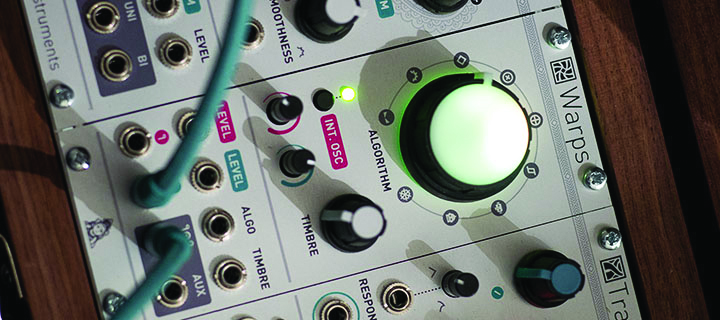
Warps’ modulation section, which seems even better thanks to the colourful, ever changing glow of the Algorithm pot
The digital incarnations were accompanied by the release of a range of four effects pedals, one of which is a modulating delay pedal called Demora. This highly capable pedal is great for all manner of delay effects, along with modulating delays which will thicken up your oscillator’s texture no end, and represents a nice modern twist on the old classic. However, one product announced at NAMM which will shortly be tempting us is from US company Strymon. These guys already have a terrific reputation for effects pedals, particularly the El Capistan tape-echo emulator and Timeline Delay.
Its first entry into the Eurorack market builds on these designs, and the Generalissimo promises to offer an incredible of delay, in a multi-head-design-based module. It’s certainly at the upper end of the module price bracket, but in common with the company’s previous delays, had many musicians salivating at the prospect of such wonderful tones.
It’s worth mentioning that both the Roland and Strymon are digital in design, with CV control, but the Strymon uses the company’s own modelling architecture to make for a highly convincing tape delay, without the need for tape. The Roland is available for a street price of £219, but we’ll have to wait for a couple of months for Strymon to release its new beast.
Wrecking Crew
All this choice in the realm of delays and reverbs is fine, and you could soundly criticise us for thinking very traditionally… Which of course we are, as these designs are nothing new, just being repackaged for a new generation and adding CV control. So let us now turn our attention to some new contenders, which
will enable us to truly mangle our audio signals into something altogether otherworldly.
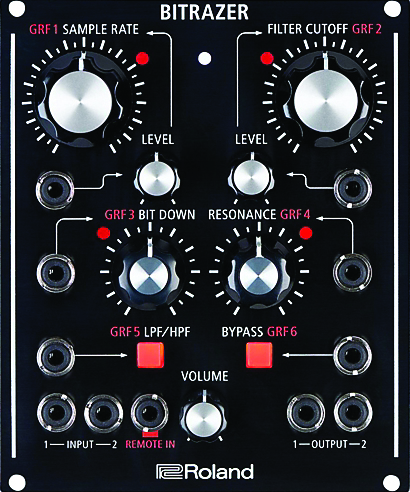
The Bitrazor is a bitcrusher and so much more besides, thanks to Roland’s flexible software
Mutable Instruments is a company with a great reputation for Eurorack modules which specialise in sonic contortion. Many of its modules not only operate using CVs and utilise an internal oscillator, but also invite an audio signal for mangling.
One such module is Warps – an inspiring module that offers a great deal of audio functionality in one unit. Billed as a ‘meta-modulator’, Warps will deliver all manner of cross modulation, including cross folding, ring modulation and even a vocoder… and who among us isn’t a complete sucker for a vocoder?
If you only have one oscillator in your arsenal, there’s an inbuilt digital oscillator to apply to your own, with a variety of waveforms to call upon. Being quite harsh in tonal quality, it’s perfect for really coarse tones that aren’t strictly distortion in the conventional sense, but which certainly deliver something in this ballpark. Warps is big on clarity, and is of course under CV control, enabling the wonderful multicoloured knob on the front to change its glow and colour as you morph from one algorithm to another, either manually or under CV control. Plus, the vocoder is Teutonic electro heaven – a definite bonus.
Rings, also from Mutable, looks at an audio signal in an altogether more acoustic way; this time resonating the incoming frequencies in much the same way that strings, membranes and tubes might in the acoustic world.
I absolutely love these kinds of modules; you know you’re dealing with something electronic, yet there’s a certain depth to the audio timbre which somehow reminds you of the natural acoustic world that surrounds you. Also, having so much control over the incoming audio signal means these sounds can move quickly and easily from something acoustic-sounding to something nightmarish, in the flick of a pot.
If distortion is more your thing, however, the current flavour of the month for transforming a sound into something manically distorted is the bitcrusher. Roland��’s new Bitrazer offers some superb bitcrushing effects, coupled with all manner of add-ons which are also under CV control. The appealing thing about the new breed of Roland effects units is they can be reprogrammed, via an external device, to offer far more than they appear to at first sight. However, at the most basic level, the Bitrazor offers sample- and bit-rate destruction (Roland’s words) which would normally be the preserve of the DAW-based plug-in.
Clock Dividers
If you’re working with a clock-based sequencer within your Eurorack, the chances are you’ll need to send a clock from the sequencer to something else in your Eurorack, such as a clockable LFO.
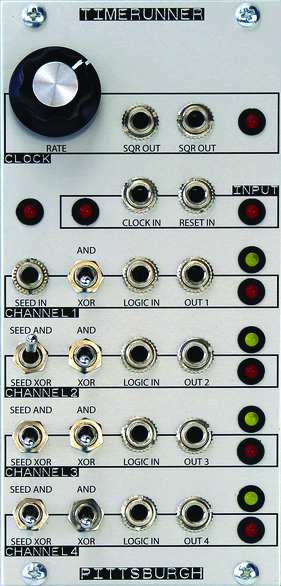
But suppose you want the LFO to travel at half the given speed? Well, that’s where clock dividers become an important part of your system. A clock divider will take an incoming clock signal, then split it into various divisions, often with their own dedicated output, so you can choose what you want and where to send it. Again, most companies make clock dividers, some more complicated than others, but a good starting point will be the A-160 from our friends at Doepfer.
It’s basic, cheap and does the job! If you need something more elaborate, check out the 4MS Rotating Clock Divider or the Pittsburgh Modular Time Runner.
Go Your Own Way
With so many modules appearing on the market at the moment, it would be absolutely impossible to mention all modules and manufacturers, so the aim here has been purely to give the boat a good healthy push from the shore, allowing the Eurorack user to go away and explore the multitude of options available.
Music technology has so much to offer and so many avenues to explore, and beyond the absolute basics, everyone has their own agenda.

Totally clockable – could this be the only LFO you will ever need?
This has never been truer than in the world of modular synthesis. One person’s 303 squelch is another person’s poison! However, the beauty of these systems and designs is very much about their simplicity, if so desired, coupled with the ability to grow into something exponentially complex as the system grows – and the user is truly in control of that destiny. As a well-known and respected synth programmer and sound designer once said: “The musician should always be looking to push the envelope.” And in the case of modular synthesis, you might literally need to push the Envelope!